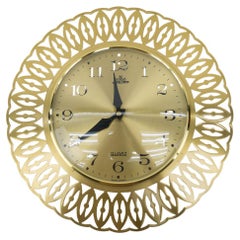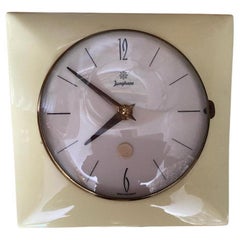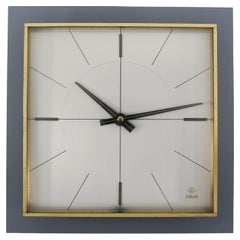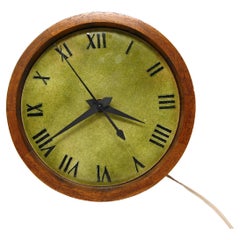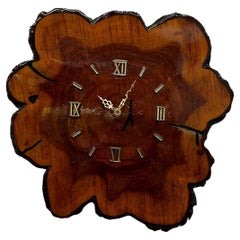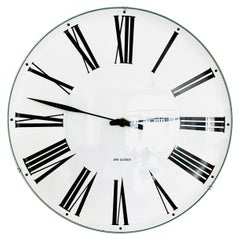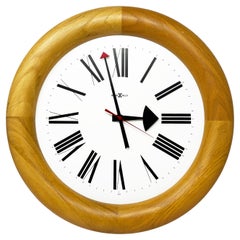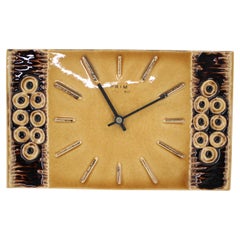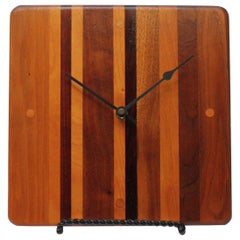Mid Century Modern Wall Clock
Vintage 1960s German Mid-Century Modern Wall Clocks
Metal
Vintage 1960s German Mid-Century Modern Wall Clocks
Ceramic
Vintage 1960s German Mid-Century Modern Wall Clocks
Metal, Brass
Mid-20th Century American Mid-Century Modern Wall Clocks
Ceramic, Walnut
Mid-20th Century American Mid-Century Modern Wall-mounted Sculptures
Wood
Mid-20th Century Danish Scandinavian Modern Wall Clocks
Stainless Steel
Mid-20th Century Mid-Century Modern Wall Clocks
Metal
Vintage 1960s Czech Mid-Century Modern Wall Clocks
Ceramic
Vintage 1970s American Mid-Century Modern Wall Clocks
Oak, Rosewood, Teak, Walnut
Vintage 1970s Czech Mid-Century Modern Wall Clocks
Aluminum
Vintage 1970s Mid-Century Modern Wall Clocks
Wood
Mid-20th Century American Mid-Century Modern Wall Clocks
Metal
Vintage 1960s Swiss Mid-Century Modern Wall Clocks
Stainless Steel
Vintage 1960s Danish Mid-Century Modern Wall Clocks
Pine
Vintage 1960s German Mid-Century Modern Wall Clocks
Metal, Brass
Vintage 1970s German Mid-Century Modern Wall Clocks
Glass
Vintage 1960s Unknown Mid-Century Modern Wall Clocks
Rattan
Vintage 1950s German Mid-Century Modern Wall Clocks
Brass
Vintage 1970s Mid-Century Modern Wall Clocks
Wood
Vintage 1960s American Mid-Century Modern Wall Clocks
Metal
Mid-20th Century Mid-Century Modern Wall Clocks
Brass
Late 20th Century German Mid-Century Modern Wall Clocks
Metal, Brass
Vintage 1960s German Mid-Century Modern Wall Clocks
Bronze
Vintage 1960s Italian Mid-Century Modern Wall Clocks
Metal
Mid-20th Century American Mid-Century Modern Wall Clocks
Metal
Vintage 1950s Austrian Mid-Century Modern Wall Clocks
Brass
Vintage 1970s Italian Modern Wall Clocks
Metal
Vintage 1960s German Mid-Century Modern Wall Clocks
Metal, Brass
Vintage 1960s German Mid-Century Modern Wall Clocks
Metal, Brass
Vintage 1960s German Mid-Century Modern Wall Clocks
Metal, Brass
Vintage 1960s German Mid-Century Modern Wall Clocks
Metal, Brass
Vintage 1960s German Mid-Century Modern Wall Clocks
Metal, Brass
Vintage 1960s German Mid-Century Modern Wall Clocks
Metal, Brass
Mid-20th Century Mid-Century Modern Wall Clocks
Metal
Vintage 1960s German Mid-Century Modern Wall Clocks
Metal, Brass
Vintage 1960s German Mid-Century Modern Wall Clocks
Metal, Brass
Vintage 1960s German Mid-Century Modern Wall Clocks
Metal, Brass
Vintage 1960s German Mid-Century Modern Wall Clocks
Metal, Brass
Mid-20th Century American Mid-Century Modern Wall Clocks
Metal, Enamel
Vintage 1960s Czech Mid-Century Modern Wall Clocks
Metal
Vintage 1970s German Mid-Century Modern Wall Clocks
Metal
Mid-20th Century British Mid-Century Modern Wall Clocks
Metal, Brass
Vintage 1960s Danish Mid-Century Modern Wall Clocks
Teak
Vintage 1960s German Mid-Century Modern Wall Clocks
Metal, Brass
Vintage 1960s German Mid-Century Modern Wall Clocks
Metal, Brass
Vintage 1960s German Mid-Century Modern Wall Clocks
Metal, Brass
Vintage 1960s German Mid-Century Modern Wall Clocks
Metal, Brass
Vintage 1960s German Mid-Century Modern Wall Clocks
Metal, Brass
Mid-20th Century Mid-Century Modern Wall Clocks
Brass
Vintage 1970s German Mid-Century Modern Wall Clocks
Resin
Vintage 1970s Chinese Mid-Century Modern Wall Clocks
Plastic, Polystyrene
Vintage 1950s French Mid-Century Modern Wall Clocks
Gold Plate
Mid-20th Century German Mid-Century Modern Wall Clocks
Plastic
Vintage 1950s Czech Mid-Century Modern Mantel Clocks
Bakelite
Vintage 1960s German Mid-Century Modern Wall Clocks
Composition, Metal
Mid-20th Century German Mid-Century Modern Wall Clocks
Metal, Brass
Mid-20th Century German Mid-Century Modern Wall Clocks
Copper
Vintage 1960s German Mid-Century Modern Wall Clocks
Metal
Mid-20th Century American Mid-Century Modern Wall Clocks
Metal
Mid-20th Century German Mid-Century Modern Wall Clocks
Metal, Aluminum, Brass, Sheet Metal, Enamel
- 1
- ...
Mid Century Modern Wall Clock For Sale on 1stDibs
How Much is a Mid Century Modern Wall Clock?
A Close Look at Mid-Century Modern Furniture
Organically shaped, clean-lined and elegantly simple are three terms that well describe vintage mid-century modern furniture. The style, which emerged primarily in the years following World War II, is characterized by pieces that were conceived and made in an energetic, optimistic spirit by creators who believed that good design was an essential part of good living.
ORIGINS OF MID-CENTURY MODERN FURNITURE DESIGN
- Emerged during the mid-20th century
- Informed by European modernism, Bauhaus, International style, Scandinavian modernism and Frank Lloyd Wright’s architecture
- A heyday of innovation in postwar America
- Experimentation with new ideas, new materials and new forms flourished in Scandinavia, Italy, the former Czechoslovakia and elsewhere in Europe
CHARACTERISTICS OF MID-CENTURY MODERN FURNITURE DESIGN
- Simplicity, organic forms, clean lines
- A blend of neutral and bold Pop art colors
- Use of natural and man-made materials — alluring woods such as teak, rosewood and oak; steel, fiberglass and molded plywood
- Light-filled spaces with colorful upholstery
- Glass walls and an emphasis on the outdoors
- Promotion of functionality
MID-CENTURY MODERN FURNITURE DESIGNERS TO KNOW
- Charles and Ray Eames
- Eero Saarinen
- Milo Baughman
- Florence Knoll
- Harry Bertoia
- Isamu Noguchi
- George Nelson
- Danish modernists Hans Wegner and Arne Jacobsen, whose emphasis on natural materials and craftsmanship influenced American designers and vice versa
ICONIC MID-CENTURY MODERN FURNITURE DESIGNS
- Eames lounge chair
- Nelson daybed
- Florence Knoll sofa
- Egg chair
- Womb chair
- Noguchi coffee table
- Barcelona chair
VINTAGE MID-CENTURY MODERN FURNITURE ON 1STDIBS
The mid-century modern era saw leagues of postwar American architects and designers animated by new ideas and new technology. The lean, functionalist International-style architecture of Le Corbusier and Bauhaus eminences Ludwig Mies van der Rohe and Walter Gropius had been promoted in the United States during the 1930s by Philip Johnson and others. New building techniques, such as “post-and-beam” construction, allowed the International-style schemes to be realized on a small scale in open-plan houses with long walls of glass.
Materials developed for wartime use became available for domestic goods and were incorporated into mid-century modern furniture designs. Charles and Ray Eames and Eero Saarinen, who had experimented extensively with molded plywood, eagerly embraced fiberglass for pieces such as the La Chaise and the Womb chair, respectively.
Architect, writer and designer George Nelson created with his team shades for the Bubble lamp using a new translucent polymer skin and, as design director at Herman Miller, recruited the Eameses, Alexander Girard and others for projects at the legendary Michigan furniture manufacturer.
Harry Bertoia and Isamu Noguchi devised chairs and tables built of wire mesh and wire struts. Materials were repurposed too: The Danish-born designer Jens Risom created a line of chairs using surplus parachute straps for webbed seats and backrests.
The Risom lounge chair was among the first pieces of furniture commissioned and produced by celebrated manufacturer Knoll, a chief influencer in the rise of modern design in the United States, thanks to the work of Florence Knoll, the pioneering architect and designer who made the firm a leader in its field. The seating that Knoll created for office spaces — as well as pieces designed by Florence initially for commercial clients — soon became desirable for the home.
As the demand for casual, uncluttered furnishings grew, more mid-century furniture designers caught the spirit.
Classically oriented creators such as Edward Wormley, house designer for Dunbar Inc., offered such pieces as the sinuous Listen to Me chaise; the British expatriate T.H. Robsjohn-Gibbings switched gears, creating items such as the tiered, biomorphic Mesa table. There were Young Turks such as Paul McCobb, who designed holistic groups of sleek, blond wood furniture, and Milo Baughman, who espoused a West Coast aesthetic in minimalist teak dining tables and lushly upholstered chairs and sofas with angular steel frames.
Generations turn over, and mid-century modern remains arguably the most popular style going. As the collection of vintage mid-century modern chairs, dressers, coffee tables and other furniture for the living room, dining room, bedroom and elsewhere on 1stDibs demonstrates, this period saw one of the most delightful and dramatic flowerings of creativity in design history.
Finding the Right wall-clocks for You
Antique, new and vintage wall clocks have become available over the years in a diverse range of materials, such as wood, metal and glass, as well as styles from mid-century modern to Industrial.
Wall clocks have been designed by acclaimed creators and manufacturers such as Howard Miller Clock Company, Junghans Uhren GmbH, Pragotron and more. The Ball clock and Sunflower clock, which were created by designer Irving Harper in George Nelson’s studio during the mid-century era, are known to design enthusiasts and have become highly collectible over the years.
Whether you want an antique timepiece or one that will match a modern motif, you are sure to find one to suit any home or office decor.
The wall clocks of today have come a long way from the mechanical timepieces that originated in the 14th century. One of the most famous clocks from this era was made by Italian astronomer and physician Giovanni de’ Dondi and took approximately 16 years to complete. By the 17th century, wall clocks were popular luxury objects for the home.
Wall clock choices are not limited to just something that keeps time. A 19th-century bronze cartel clock and barometer set is an elegant addition to a foyer, while a vintage world-map clock allows you to see the time in several locations at once. Cleverly designed clocks have been created for all manner of tastes over the years.
On 1stDibs, you will find wall clocks and other types of antique and vintage clocks from various time periods, from Louis XV to Art Deco, and from all over the world, including Germany, France, the United Kingdom and elsewhere. Bring a touch of class and personality into your living room or dining room with a unique timepiece.
Read More
How Noguchi Elevated Ashtrays to Objets d’Art
Smoking might have fallen out of fashion, but these ashtrays have enduring design appeal.
Jeff Andrews Captures Old Hollywood Glamour in His Cinematic Spaces
Having created extravagant homes for reality TV’s biggest stars, the designer is stepping into the spotlight with his first book.
Tapio Wirkkala Bucked the Trends of Mid-Century Nordic Design
The Finnish talent created nature-inspired pieces, from furniture to jewelry, with phenomenal staying power.
